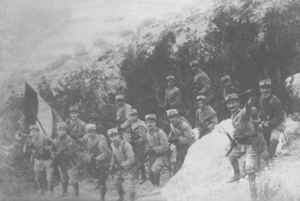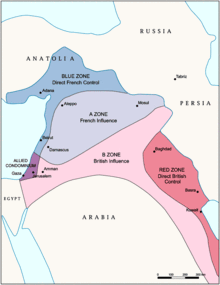French occupation of Cilicia
| date | December 1918 to October 1921 |
|---|---|
| place | Cilicia and Upper Mesopotamia |
| Casus Belli | Division of the Ottoman Empire |
| output | France gives up some border areas with Syria |
| Peace treaty | Treaty of Cilicia, Treaty of Ankara , Treaty of Lausanne |
| Parties to the conflict | |
|---|---|
|
|
|
The French occupation of Cilicia or the Cilician War ( French La campagne de Cilicie , German: The Cilician Campaign ; Turkish Güney Cephesi , German: The Southern Front ) was a series of conflicts between France and the Turkish independence movement after the end of the First World War . The conflict lasted from December 1918 to October 1921 and took place in what is now southern Turkey and northern Syria.
The French showed interest in the area with the Sykes-Picot Agreement and the Franco-Armenian Agreement of 1916. But after 1921 France distanced itself from the Triple Entente and moved closer to the new Turkish national government in Ankara and concluded with it the Treaty of Ankara , also known as the Franklin Bouillon Agreement.
background
The interest of the French in the Çukurova region was evident as early as 1798 with Napoleon's Egyptian expedition .
In 1909 France took part in the Mercimek Çiftliği of Sultan Abdülhamid II. This huge farm with an area of 1100 km² stretched as a strip from the port of Yumurtalık and Karataş to the plains of Kozan and İmamoğlu.
agreement
The war between the Ottoman Empire and the Entente ended with the armistice of Mudros (October 30, 1918) . The French army marched into the region under the secret Sykes-Picot agreement. According to this agreement, in addition to Syria , the French should also get southern Anatolia with its important strategic and economically significant places such as the fertile plains of Çukurova, the seaports of Mersin and İskenderun and the copper mines of Ergani. On the other hand, the oil reserves in the Ottoman province of Mosul belonged to the British alone. According to the agreement, the British were to occupy the cities of Antep , Maraş and Urfa and later leave them to the French.
On October 27, 1916, France signed an agreement with the Armenian nationalists. The Foreign Minister Aristide Briand took this opportunity and recruited soldiers from the Armenians. These French-Armenian legions were to be under the command of Edmund Allenby and later fought in Palestine and Syria. After the Mudros armistice, they also fought in Cilicia. With the help of these legions, southern Anatolia was to be separated from the Ottoman Empire.
French occupation of Turkey
Landing on the Black Sea coast
After the Mudros armistice, the French military secured the important Ottoman coal mines on the Black Sea, in which French companies had large stakes. This served to secure the energy sources and to supply the army with coal. French troops prevented the distribution of coal in Anatolia and tried to stir up unrest among the people.
On March 18, 1919, two French gunboats set troops to the ports of Zonguldak and Ereğli . The French were only able to stay in Karadeniz Ereğli for a year due to resistance and left the city on June 8, 1920. They strengthened their position in Zonguldak and officially occupied the entire city from June 18, 1920.
Military operations in Istanbul and Thrace
France took part in the occupation of Istanbul with the other allies and invaded the city on November 12, 1918. On February 8, 1919, the French general Franchet d'Esperey arrived in Istanbul. As commander in chief of the Allied troops, he was supposed to coordinate the work of the Ottoman government.
The French also held the city of Bursa , which was of great importance as the former Ottoman capital, for a short time. In May Greece attacked Turkey and started the Greco-Turkish War . At first it advanced successfully on Turkish territory. With the summer offensive of the Greeks in Anatolia in 1920, Bursa fell to the Greeks.
The Cilicia Campaign
The French landed in Mersin on November 17, 1918 , with 15,000 mostly volunteers from the French-Armenian Legion and 150 French officers. The first goals of this expeditionary force were the occupation of the ports and the removal of the Ottoman administration. The second landing took place on November 19, 1918 in Tarsus and should secure the area and make preparations to set up the French headquarters in Adana .
After the occupation of Kilkien in late 1918, French troops occupied the Ottoman Vilâyets of Antep, Maraş and Urfa in southern Anatolia in 1919 . These places were given to them by the British as agreed. As the easternmost point of the zone of occupation, Mardin was occupied on November 21, 1919. However, the occupation was broken off again after a day.
The French governors of Cilicia were Édouard Brémond from January 1, 1919 to September 4, 1920 and Julien Dufieux from September 1920 to December 23, 1921. From the beginning, the French met with stiff resistance from the inhabitants of the occupied territories. The situation was explosive because the Armenians were working with the French.
The French wanted to own the areas in Syria and the adjacent Taurus Mountains , but the Taurus was very important to the Turks under Mustafa Kemal . The French, who were ignorant of the area, were helped by the Armenian militias with information about the area, while the Arab tribes of the region worked with Ankara. In contrast to the Greek armies in Western Anatolia, the French posed less of a threat to the Turks. Mustafa Kemal assumed that the French would give up quickly if the Greeks were defeated.
The local resistance took the French by surprise. They blamed the British on the ground and accused them of not fighting the resistance enough. The French strategy of opening a southern front failed after the defeat of the Greeks and British in the west.
On November 1, 1919, two days after the occupation, the Sütçü-İmam incident occurred . Sütçü İmam came to the aid of three women who were harassed and molested by Armenian soldiers from the occupying forces. Sütçü İmam shot one of the troublemakers and had to go underground. The incident sparked a series of events that turned the Turkish majority of the city against the occupation forces. Two months after the incident, the riot broke out across the city. After 22 days, the French were forced to evacuate Maraş on February 11, 1920. The Armenian community of Maras followed the French out of fear of revenge. Soon thereafter, the resistance fighters from Maraş supported the surrounding occupied cities.
Peace treaty and the end of hostilities
The Cilicia Peace Treaty was signed between the two sides on March 9, 1921. The contract was then replaced by the Ankara Treaty on October 20 of the same year. A little later, the Turkish War of Independence ended with the Mudanya Armistice .
retreat
The French began their retreat in early 1922. They evacuated Mersin and Dörtyol on January 3, and Adana , Ceyhan and Tarsus on January 5 . The evacuation was completed on January 7th when the last troops left Osmaniye. At the beginning of the war, the French, in cooperation with the Greeks, crossed the Mariza river in 1919 and occupied the city of Uzunköprü in eastern Thrace and the railway lines to Hadımköy near Çatalca at the gates of Istanbul. After the Greeks were driven back from Western Anatolia in September 1922, the French and British were also driven from their positions near the Dardanelles . So the French withdrew with the Greeks behind the Mariza.
Effects
France's relationship with the government in Ankara improved. The Ankara Treaty of 1921 did not solve the problem of the Sanjak Alexandrette . According to Ankara, Alexandrette belonged to the Misak-ı Millî and was thus part of the Turkish territory. The remaining, mostly Arab-populated areas in Syria were left to France. Syria became a French mandate . The unsolved problem with Alexandrette led to tension in the otherwise friendly relations between France and Turkey. Another problem between France and Turkey was the Ottoman Empire's indebtedness to France. This problem was solved with the Lausanne Conference.
Web links
- Cilicia Campaign (1919–1921): Birth of modern Turkey , website about the French occupation of Cilicia with documents and photos
Individual evidence
- ↑ Millî Mücadele'de İlk Kurşun ve Dörtyol'un Düşman İşgalinden Kurtuluşu ( Memento of the original from March 15, 2018 in the Internet Archive ) Info: The archive link was inserted automatically and has not yet been checked. Please check the original and archive link according to the instructions and then remove this notice.
- ↑ Marko Djuranovic: Democracy Or Demography? Sources of Victory in Modern War , 2008, ISBN 978-3-63908-313-2 , p. 190 .
- ↑ Stanley Elphinstone Kerr: The Lions of Marash: personal experiences with American Near East Relief, 1919-1922 , p. 30.


